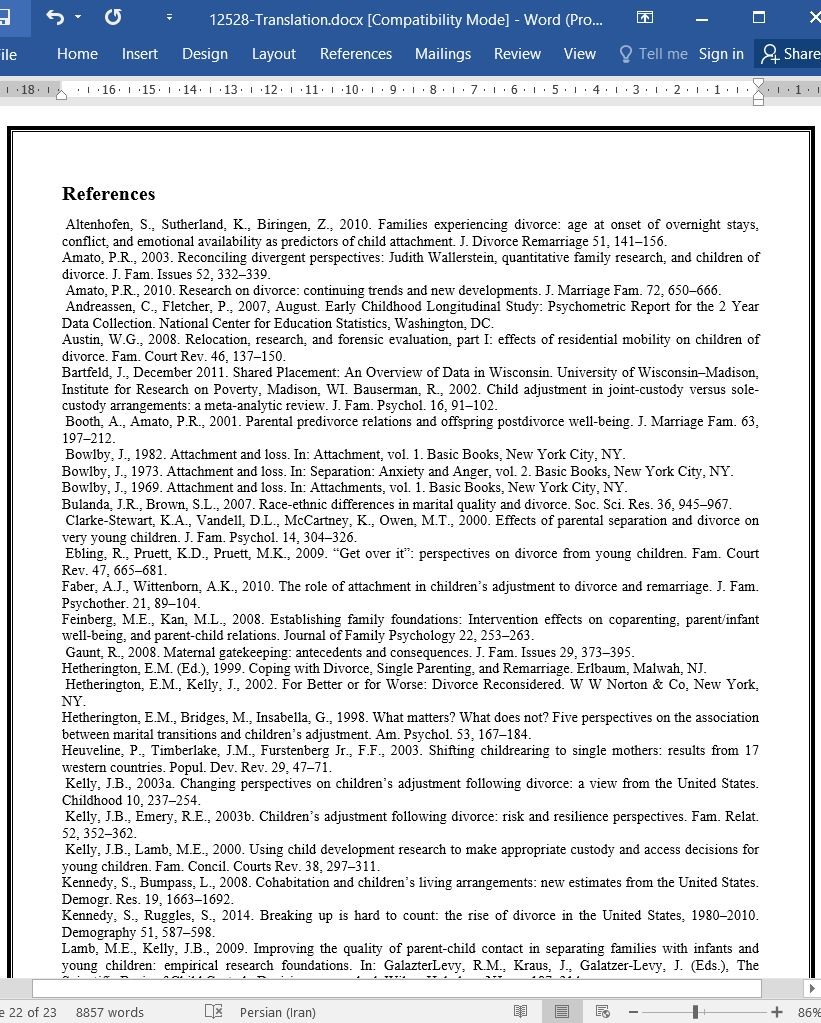
دانلود مقاله اثرات طلاق بر کودکان کم سن و سال
مقدمه
به رغم میزان بالای طلاق، مطالعات نسبتاً معدودی در مورد تأثیرات طلاق بر کودکان کم سن و سال در ایالات متحده صورت گرفته است. در مطالعات حاضر با وجود گستره تحقیقاتی کوچک ثابت شده است که کودکان کم سن و سال با مشکلات ناشی از طلاق از جمله کاهش فرزندپروری، رویارویی با درگیری والدین، مشکلات رفتاری و عاطفی و هم چنین بی ثباتی اقتصادی و اقامتی مواجه هستند. با آنکه طلاق میتواند برای کودکان کم سن و سال زیانآور باشد، نتایج تحقیقات نیز نشان داده است که کودکان کم سن و سال سرسخت و مقاوم اند. نتایج مطالعات حاکی از آن است که اقامتهای یک شبه با والد فاقد حق حضانت، تمهیدات حضانت مشترک، روابط فرزندپروری با کشمکش کم، برنامه ریزی والدین و نیز برخی انواع مداخلات خانوادگی این قابلیت را دارند که موانع پیش روی کودکان را رفع کنند. بنابراین، در تحقیقات اخیر، بر تاب آوری کودکان پس از طلاق تأکید شده است. بسیاری از کودکان با مشکلات ناشی از طلاق روبرو هستند، اما خانوادهها اغلب به مرور زمان مجدداً ثبات پیدا میکنند و اغلب کودکان نیز بدون مواجهه با مشکلات بلند مدت وارد دوران بزرگسالی میشوند.
طلاق در خانوادههای دارای کودکان کم سن و سال در آمریکا
میزان طلاق در سراسر ایالات متحده به خصوص در میان زوجهای کم سن وسال تر که از نظر تعداد سالهای فرزندآوری شان محتمل تر بوده، کاهش یافته است (کندی و روگلز، 2014). با وجود این، شماری از کودکان کم سن و سال با طلاق والدین شان مواجه خواهند شد. طبق برآوردهایی که اخیراً در نظرسنجی 2017 امریکن کمیونتی (جامعه آمریکا) انجام گرفته است، حدود 4/5 درصد کودکان تا رده سنی ۳ سال با والدی که در حال حاضر جدا شده است، زندگی میکنند. علاوه بر این، از بین تمام کودکانی که با والد مطلقه زندگی میکنند، 15 درصد در رده سنی تا ۳ سال بودند. اذعان به وجود تفاوتهای جزئی در این ارقام نیز جهت درک تغییرات صورت گرفته در گذر زمان در خانوادههای ایالات متحده تعیین کننده است. برای مثال، در این ارقام، کودکان دارای والد جدا شده که بعداً ازدواج مجدد میکند، ثبت نمی شوند. علاوه بر این، در این داده ها، کودکانی که با والدین همخانه (بدون ازدواج رسمی) متولد میشوند، مورد ارزیابی قرار نمیگیرند که طبق برآوردهای اخیر حدود ۲۰ درصد تولدها را تشکیل می دهند. به علاوه، این والدین ممکن است بعداًً از هم جدا شوند، به خصوص از آنجا که محققان دریافتند احتمال قطع دلبستگی والدین کودکان در دلبستگیهای همخانه دو برابر بیشتر از کودکانی است که والدین شان با هم ازدواج رسمی کردهاند (هوولاین و همکاران، 2003 ؛ کندی و بامپس، 2008). از این رو، بسیاری از کودکانی که والدین ازدواجکرده یا همخانه دارند، در معرض عواقب طلاق یا قطع دلبستگی والدین خود هستند. به رغم شیوع طلاق در بین خانوادههای کودکان کم سن و سال، هنوز تعداد مطالعاتی که منحصراً بر عواقب جدایی والدین در این گروه سنی متمرکز شده باشد، نسبتاً کم میباشند. کودکان کم سن و سال در مواجهه با مشکلات زناشویی دچار مشکل میشوند و اغلب از استرس و هم چنین مشکلات رفتاری یا عاطفی پس از طلاق والدینشان رنج میبرند. علاوه بر این، بسیاری از کودکان پس از طلاق والدین شان آسیب پذیر هستند، زیرا آنها اغلب نوع و میزان دسترسی یکسان به والدی که احتمالاً نقش تعیین کنندهای در حمایت عاطفی و هم چنین مالی از کودک داشته است، را از دست میدهند (هترینگتون و کلی، 2002). طلاق نیز رویدادی مجزا به حساب نمیآید، یعنی مشکلات کودکان مانند تجربه درگیری والدین معمولاً جلوتر از تاریخ واقعی طلاق واقع میشود. به همین ترتیب، سازگاری کودکان با طلاق یک شبه اتفاق نمیافتد و اغلب ممکن است سالها طول بکشد تا کودکان به جدایی والدین خود عادت کنند (آماتو، ۲۰۱۰).
نتیجهگیری و دستورالعملهای آینده
بسیاری از کودکان کم سن وسال، پایان ازدواج والدین شان را تجربه خواهند کرد. این کودکان هم در طی مراحل طلاق و هم پس از آن با پیامدهای متعدد ناشی از طلاق روبرو میشوند. کودکان کم سن و سال اغلب فاقد مهارتهای رویارویی برای سازگاری کامل یا درک طلاق والدین خود هستند. طلاق تقریباً همیشه از دست دادن یک والد از روال عادی روزانه کودک را با خود دارد که نه تنها ممکن است موجب نگرانی کودک شود، بلکه ممکن است دلبستگی کودکان به والدین شان را نیز تهدید کند. علاوه بر این، کودکان هم قبل و هم پس از طلاق ممکن است در معرض درگیری بین والدین قرار بگیرند که در برخی موارد میتواند پیامدهای ناخوشایندی برای کودکان به همراه داشته باشد. وانگهی، بسیاری از والدین با فشار عاطفی زیادی پس از طلاق روبرو میشوند و در نتیجه کودکان اغلب غفلت از فرزند پروری را پس از طلاق تجربه میکنند. این امر ممکن است شامل محبت، حمایت و توجه کمتر و نیز گرایش برخی والدین دارای حق حضانت برای رفتار جبری تر به هنگام تربیت فرزندان شان باشد. کودکان با وجود سن کم شان ممکن است جابجایی نقش انجام دهند که در آن مسئولیت شخص والد را بر عهده میگیرند و با این کار به مادر یا پدر ناراحت خود دلداری میدهند. کودکان کم سن و سال اغلب با مجموعهای از شرایط جدید مانند تمهیدات جدید حضانت و ملاقاتهای یک شبه احتمالی با والد فاقد حق حضانت و نیز تغییرات صورت گرفته در شرایط اقتصادی و محل سکونت خود سازگار میشوند. با وجود اینکه طلاق چالشهای زیادی بوجود میآورد که کودکان کم سن وسال باید با آنها مواجه شوند، گستره رو رشد تحقیقات نشان میدهد که کودکان اغلب پس از طلاق کاملاً سرسخت و مقاوم هستند. در ابتدای غفلت از تربیت به نظر میرسد که کودکان به مرور زمان با طلاق سازگار شوند و چند سال بعد معمولاً نتایجی مشابه همسالان خود در خانوادههای سالم خواهند داشت.
Introduction
Despite high divorce rates, there are relatively few studies on the effects of divorce on very young children in the United States. Despite this small body of research, existing studies have shown that young children face challenges linked to divorce including diminished parenting, exposure to parental conflict, and behavioral and emotional issues, as well as economic and residential instability. Although divorce can be detrimental to very young children, research has also shown that young children are resilient. Studies have reported that overnight stays with the noncustodial parent, joint custody arrangements, low conflict parenting relationships, parental planning, and some types of family interventions have the potential to assuage challenges faced by children. Thus, recent research has underscored the resilience of children following divorce. Even though many children face difficulties associated with divorce, families often restabilize with time, and most children move into adulthood without facing long-term problems.
Divorce in Families With Very Young Children in the United States
Divorce rates have declined across the United States, especially among younger couples who are also more likely to be in their childbearing years (Kennedy and Ruggles, 2014). Nonetheless, a number of young children will experience their parents’ divorce. According to recent estimates from the 2017 American Community Survey, about 5.4% of children ages 0 to 3 live with a currently divorced parent. Moreover, out of all children living with a divorced parent, 15% of these children were between the ages of 0 and 3. Acknowledging the nuances in these numbers is also crucial for understanding changes to families in the United States over time. For example, these numbers do not capture children who have a divorced parent who later remarries. Further, these data do not assess children who are born to cohabiting parents, which according to recent estimates comprise about 20% of births. Moreover, cohabiting parents may later split, especially as researchers find that children in cohabiting unions are twice as likely to see their parents dissolve their union relative to children with married parents (Heuveline et al., 2003; Kennedy and Bumpass, 2008). Thus, many children with married or cohabiting parents are susceptible to the consequences of their parents’ divorce or union dissolution. Despite the prevalence of divorce among young children, there are still relatively few studies that have focused exclusively on the consequences of parents’ breakup for this age group. Young children face difficulty in coping with marital dissolution and often experience stress as well as behavioral or emotional problems following their parents’ divorce. Further, many children are disadvantaged after their parents’ divorce because they often lose the same type and amount of access to one parent who was likely a crucial provider of both emotional and financial support to the child (Hetherington and Kelly, 2002). Divorce is also not a discrete event, meaning children’s problems, such as the experience of parental conflict, often precede the actual date of the divorce. Likewise, children’s adjustment to divorce does not occur overnight; it can often take children years to acclimate to a parental separation (Amato, 2010).
Conclusions and Future Directions
Many young children will experience the end of their parents’ marriage. Both during the divorce proceedings and after, young children face several divorce-related consequences. Very young children often lack the coping skills to fully adjust to or understand their parents’ divorce. Divorce almost always involves the loss of one parent from the child’s daily routine, which may not only create worry for the child but may also threaten children’s attachment to their parents. Additionally, both before and after divorce, children may be exposed to conflict between parents, which can be associated with adverse outcomes for children in some cases. Further, many parents face enormous emotional stress following a divorce, and thus, as a result, children often experience compromised parenting following a divorce. This may include less affection, support, and attention, as well as the tendency for some custodial parents to act more coercively when parenting their children. Despite their young age, children may go through role reversal where they assume the responsibility of the parental figure, offering comfort to their distressed mother or father. Young children often adjust to a host of new circumstances, such as new custody arrangements and potential overnight visits with the noncustodial parent as well as changes in their economic circumstances and residences. Even though divorce brings about numerous challenges that young children must encounter, a growing body of research suggests children are often quite resilient after divorce. Although initially compromising, children seem to adapt to divorce over time and tend to have similar outcomes as their peers from intact families years later.
مقدمه
طلاق در خانوادههای دارای کودکان کم سن و سال در آمریکا
مشکلات منحصر به فرد کودکان کم سن و سال نسبت به کودکان سنین بالاتر
واکنش کودکان به طلاق والدین
تحقیقات درباره دلبستگی
کاهش فرزندپروری در پی طلاق
کشمکش والدین
دروازه بانی مادرانه
اقامتهای یک شبه
توافق بر سر حضانت کودکان
تفاوتهای جنسیتی در کودکان
سایر مسائل تأثیرگذار بر کودکان کم سن و سال
تاب آوری کودکان کمسن و سال
نتیجهگیری و دستورالعملهای آینده
منابع
Introduction 1
Divorce in Families With Very Young Children in the United States
Unique Difficulties of Younger Children Versus Older Children
Children’s Reactions to Parents’ Divorce
Attachment Research
Diminished Parenting Following Divorce
Parental Conflict
Maternal Gatekeeping
Overnight Stays
Child Custody Arrangements
Gender Differences Among Children
Other Issues Affecting Young Children
Resiliency of Young Children
Conclusions and Future Directions
References
- ترجمه فارسی مقاله با فرمت ورد (word) با قابلیت ویرایش، بدون آرم سایت ای ترجمه
- ترجمه فارسی مقاله با فرمت pdf، بدون آرم سایت ای ترجمه


